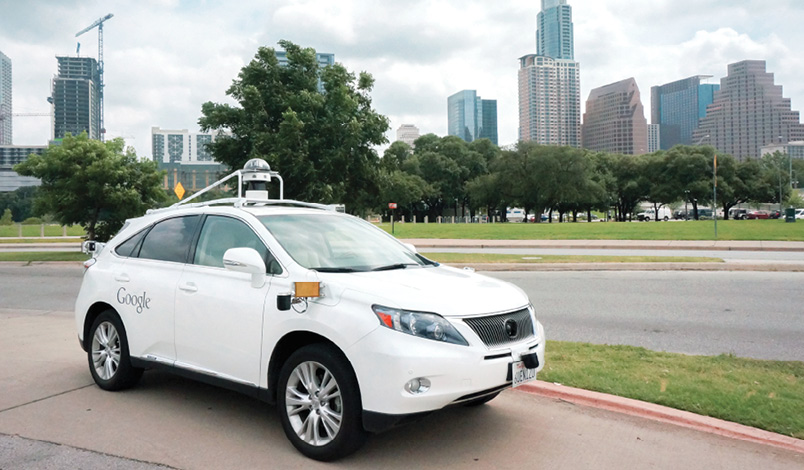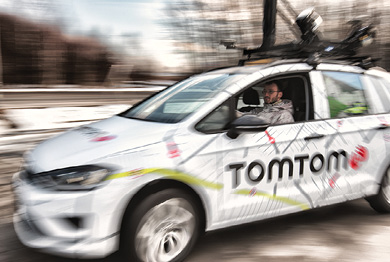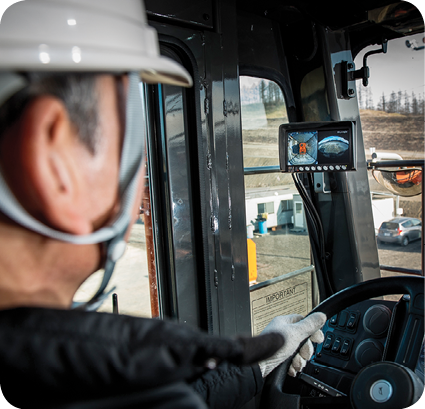
Nissan is integrating advanced vehicle control & safety technologies with AI to develop practical, real-world applications of autonomous drive technology. Nissan N.A.
Some firms see the way to the driverless car as straight and quick, aiming to revolutionize the way we move in one fell swoop. Meanwhile, established carmakers are taking a different route, betting on a step-by-step approach that keeps the driver in the mix—at least for now.
Alexander Hars is a thought leader, entrepreneur and managing director of the consulting firm Inventivio GmbH, based in Nurnberg. He said the driverless car is a potential paradigm changer, and Google has a big head start over existing automotive companies. The fact that it doesn’t have an existing car business to support has allowed it to think freely, and the speed at which it has moved forward is going to change everything.
“It is very clear, Har said, “that once you have a fully autonomous car, you are going to change many aspects of mobility. The car-sharing and autonomous-taxi fleet models, based on driverless cars, will completely transform the auto industry.”
Defending the approach of that industry is Richard Candler, general manager for Advanced and Cross Car Product Strategy at Nissan Europe. In contrast to the full-speed-ahead Google approach, Candler said, Nissan, over time, has been gradually freeing drivers from some of the stressful aspects of driving a car through advanced ‘assisted driving’ technologies.
“Nissan is enhancing driving through the development and evolution of Autonomous Drive,” he said, “with existing technologies such as the Nissan Safety Shield [monitoring vehicle systems and the outside driving environment] and Around View Monitor [providing a virtual 360-degree view].”
And there’s more to come. “The next step will be the widespread introduction of in-lane Autonomous Drive, which is able to manage driving in the same lane—for example driving in traffic or on the highway,” Candler said. “After that we will introduce a system that can manage speed and lane keeping, in traffic jams or on the highway, allowing multi-lane movement, for example overtaking slower cars.”
And finally, Candler said, “The third stage would be the ability to manage city intersections, turns and typical maneuvers in the city, in addition to the capabilities of the previous systems.”
Not exactly the Google car, but then again, Candler said, we’re not talking about decades either: “The first of these systems will be on the market from 2016, with a successive roll-out toward 2020,” he said, “when full Autonomous Drive systems will be available.”
In contrast to the more direct approach to the driverless car, Candler said, “At Nissan we believe our approach is unique, first of all because our system is based on already-proven Nissan Safety Shield technologies, which are being used today by hundreds of thousands of drivers.
Many of the ‘driverless vehicles’ we see under development focus on low-speed, inner-city mobility on specially prepared routes, where Nissan is focusing on adding Autonomous Drive technology to our current and future mainstream production vehicles. Our approach is based on customer research, so our focus is on how we can improve and support the driver rather than taking over altogether.”

Google tested its self-driving technology in Austin, TX over the summer using augmented Lexus RX450h SUV’s. Google
A Common Path
Jan-Maarten de Vries is vice-president, Product Management and Marketing, for TomTom Netherlands. He said he sees the gradual move toward road vehicle automation described by Candler as “a standard approach we will see with most if not all established car makers. They will move step-by-step and gradually through different levels of automated driving that have been defined.”
And, de Vries said, he believes neither the direct ‘Google-style’ approach nor the more gradual ‘step-wise’ approach is better or worse.
“The two approaches are certainly different,” he said. “The traditional carmakers are going step-by-step because they have to tie the new technologies into their existing business models.
“The advantage of this approach is that it allows them to test the technology and make it more safe, test new business models, tie it into their brand strategy—e.g. around safety like Volvo—and introduce commercial ADAS (Advanced Driver Assistance Systems) such as Traffic Jam Assist, Highway Pilot, Super Cruise Control, Country Road Assist, etc. Their customers will gradually get more familiar with automated technologies and this will help consumer adoption of self-driving cars over the longer term.”
Off the Beam?
For his part, Hars thinks the step-by-step approach is simply not viable; with assisted systems, while the driver is not exactly ‘driving,’ he/she is not ‘not-driving’ either. The gradual approach adds various in-between steps—Level 1, Level 2, etc.,—where control is gradually taken away. At some point that puts the driver/passenger in the position of having to supervise the assisted systems, as they engage and then disengage.
Not all of the technology being tested today is ready for that transition, Hars said, predicting that it is “only a matter of time before we start seeing the first accidents due to this kind of vehicle system.”
“Humans are just not capable of remaining alert and vigilant for hours and hours while their car drives [semi-]autonomously,” he said. “Regulators need to step in quickly, but they do not seem to be too concerned or even aware of the problem yet.”

TomTom’s HD map of the Autobahn made using this mapping vehicle, will give automated cars additional reference points.
Market Disruption
Hars said the classic business model of ‘we-build-a-car-and-sell-it-to-an-end-user/driver’ is on the way out, and this is where the established makers are at a disadvantage. Google is going straight to the driverless car in part because it can, “because it does not have to cannibalize its own car business,” because it doesn’t have a car business.
He calculates driverless fleets will reduce costs by 1/3 to ½ compared to everyone owning their own cars. Whether, or to what extent, fleet operators will chose to pass those savings on to final consumers is still an open question. And there will be plenty of “regulatory meddling,” as Hars put it, “because we are talking about a radical market restructuring.”
There also will be labor issues to resolve, judging by the reaction of established conventional taxi fleet operators and drivers to the emergence of the UBER car, and there will be the potential for the development of monopolistic scenarios. But Hars said the change is coming, like it or not. He expects to see the first autonomous car fleets in the U.S. by 2018, with Europe following quickly thereafter with its own fleets by 2020.
Once a Dream
Automated driving is coming soon, and whatever form it ultimately takes, supply chains will be deeply affected. Old businesses will fall by the wayside and new ones will flourish.
TomTom is already very active in helping the automotive industry to move toward automated driving, de Vries said. “Our mission is to provide content, software and service components that enable the automated vehicle to see beyond its physical sensors.”
In September TomTom announced it had completed a high definition (HD) map of the entire German highway system. “The HD Map is much more accurate, detailed and feature-rich than the current navigation ‘standard definition’ maps,” de Vries said, “providing an additional reference point to what the car sensors see, and it also provides a longer range.”
TomTom’s Road DNA service also provides enriched content, entailing what de Vries describes as “a continuous ‘pattern’ of the side of the road that can be embedded in the car memory and compared to what its sensors actually see, so the vehicle position can be determined accurately.”
And TomTom is developing Cloud-based services such as ‘Traffic’ and a future-proof mapping platform that can process car sensor data and keep content in the car up to date in real-time.
Similar technologies, services and applications currently being created by other groups are also feeding into and hastening the development of autonomous road transport systems.
The driverless car is no longer science fiction, de Vries said. “I believe the general public is getting more and more aware of this emerging reality. This new era has already started and is for sure more than a dream.” But, he said, the step-by-step approach also means it will take a long time before the whole car park is full of self-driving vehicles.
“In the coming years, between 2016/17 and 2025, the automotive industry will move gradually from current Level 2/3 to Level 4—what we call HAD or Highly Automated Driving—by introducing more and more active-safety/ADAS/Automated Driving features to their new cars.” de Vries said. “It will start with commercial pilot projects, for example 100 Volvo cars on the Gothenberg ring road in 2017, and then introducing more and more cars to the market.”
Truly self-driving or autonomous cars are not to be expected before 2025/30, de Vries said. That’s not quite as optimistic as Nissan’s and Hars’ projections, he said, but there are still non-technical as well as technical obstacles to be ironed out.
Among the trickier remaining issues are:
• At what point does increasing automation finally take the ‘fun’ out of driving? And what will be the consumer reaction when that realization hits?
• How to enable safe changeover between driver control and vehicle control in vehicles that are partially automated.
• How to deal with the awkward and potentially very long transition period when fully autonomous vehicles will share the road with not-yet-autonomous vehicles.
“Another obstacle I see is the need for global standards around data exchange,” de Vries said, “between cars of different makes, but also between cars and road infrastructure.”

Nissan Motor Co. Ltd. announced it has licensed its Around View Monitor and Moving Object Detection (MOD) technology, jointly developed with Clarion Co., Ltd. Nissan N.A.
Who Needs It?
Back at Nissan Europe, Candler told Inside Unmanned Systems his firm did not yet feel there was strong customer demand for a fully autonomous car. “Our research shows that our customers want to stay at the center of the driving experience.”
Nissan’s research is probably not too far off the mark. In a special 2015 ‘Eurobarometer’ survey carried out for the European Commission on the subject of ‘autonomous systems’, six out of 10 EU respondents (61%) said they would feel uncomfortable traveling in an autonomous or driverless car. Only slightly more than a third (35%) said they would feel comfortable or fairly comfortable.
“On the other hand,” Candler said, “when we focus on fixing some of the difficult situations that occur in everyday driving, like traffic jams, we do see a huge demand.” So, for now, Candler said, Nissan believes driver assistance as needed is better than a fully self-driving car. “This may change,” he allowed, “as consumers get more familiar with autonomous driving technologies over the coming years.”
“We believe Autonomous Drive is very relevant for European customers,” he said. “Our strategy is well aligned with a good business case, focusing on where the customer places value and delivering features customers want.
Technically, we have what we need to deliver a fully self-driving car. Many of the technical obstacles have already been resolved through years of research and now we are in a stage of fine-tuning, validation and confirmation, but this needs to be balanced with customer demand and the cost of delivering such a system at a reasonable price.”
And, importantly, Candler said, “the legal and regulatory frameworks around the technology are still being considered by authorities in various countries around the world. We are, of course, working with a number of key parties to solve these issues, issues that face everyone in Nissan’s position.”
TomTom’s de Vries said the good thing about the Google-style approach is that it is aimed at changing the world for the better right away.
The ultimate benefits, he suggested, are:
• Safety: automated vehicles will drive more safely than people can; human error is by far the most common cause of road accidents.
• Traffic, congestion and environment: automated vehicles will drive more efficiently than human beings, using more direct routes, improving traffic flow and fuel consumption, and lowering emissions.
• Freedom: the (former) driver can now spend time on something other than driving, and there will be better access to road-based mobility for people who are currently excluded from driving.
Either way, de Vries said , “I believe that both approaches will ultimately converge on the end stage of fully automated driving or self-driving cars.”

